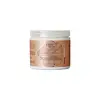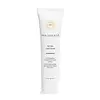What's inside
What's inside
 Key Ingredients
Key Ingredients

No key ingredients
 Benefits
Benefits

 Concerns
Concerns

 Ingredients Side-by-side
Ingredients Side-by-side

Water
Skin ConditioningStearyl Alcohol
EmollientCetyl Alcohol
EmollientGlycerin
HumectantPrunus Amygdalus Dulcis Oil
Skin ConditioningParfum
MaskingBehentrimonium Methosulfate
Cetearyl Alcohol
EmollientAlthaea Officinalis Root Extract
Skin ConditioningCocos Nucifera Oil
MaskingAloe Barbadensis Leaf Juice
Skin ConditioningHydrogenated Castor Oil/Sebacic Acid Copolymer
EmollientHydrolyzed Adansonia Digitata Seed Extract
Maltodextrin/Vp Copolymer
Panthenol
Skin ConditioningPolyquaternium-10
Theobroma Cacao Seed Butter
EmollientTribehenin
EmollientStearalkonium Chloride
PreservativeBenzyl Alcohol
PerfumingDehydroacetic Acid
PreservativeMaltol
MaskingNerolidol
PerfumingLimonene
PerfumingLinalool
PerfumingWater, Stearyl Alcohol, Cetyl Alcohol, Glycerin, Prunus Amygdalus Dulcis Oil, Parfum, Behentrimonium Methosulfate, Cetearyl Alcohol, Althaea Officinalis Root Extract, Cocos Nucifera Oil, Aloe Barbadensis Leaf Juice, Hydrogenated Castor Oil/Sebacic Acid Copolymer, Hydrolyzed Adansonia Digitata Seed Extract, Maltodextrin/Vp Copolymer, Panthenol, Polyquaternium-10, Theobroma Cacao Seed Butter, Tribehenin, Stearalkonium Chloride, Benzyl Alcohol, Dehydroacetic Acid, Maltol, Nerolidol, Limonene, Linalool
Water
Skin ConditioningCetearyl Alcohol
EmollientKaolin
AbrasiveGlycerin
HumectantVinegar
Charcoal Powder
AbrasiveOryza Sativa Bran Oil
EmollientBehentrimonium Methosulfate
Olea Europaea Fruit Extract
BleachingButyrospermum Parkii Butter
Skin ConditioningStearalkonium Chloride
PreservativeHydrolyzed Quinoa
Skin ConditioningEpilobium Angustifolium Flower/Leaf/Stem Extract
Skin ConditioningPanthenol
Skin ConditioningPotassium Sorbate
PreservativeHydrolyzed Adansonia Digitata Seed Extract
Sodium Levulinate
Skin ConditioningStearyl Alcohol
EmollientThiamine Hcl
MaskingBenzyl Alcohol
PerfumingSodium Benzoate
MaskingGlycine Soja Oil
EmollientCananga Odorata Flower Oil
MaskingCitrus Aurantium Dulcis Peel Oil
MaskingLavandula Angustifolia Oil
MaskingPogostemon Cablin Leaf Oil
MaskingSalvia Sclarea Oil
MaskingLinalool
PerfumingLimonene
PerfumingWater, Cetearyl Alcohol, Kaolin, Glycerin, Vinegar, Charcoal Powder, Oryza Sativa Bran Oil, Behentrimonium Methosulfate, Olea Europaea Fruit Extract, Butyrospermum Parkii Butter, Stearalkonium Chloride, Hydrolyzed Quinoa, Epilobium Angustifolium Flower/Leaf/Stem Extract, Panthenol, Potassium Sorbate, Hydrolyzed Adansonia Digitata Seed Extract, Sodium Levulinate, Stearyl Alcohol, Thiamine Hcl, Benzyl Alcohol, Sodium Benzoate, Glycine Soja Oil, Cananga Odorata Flower Oil, Citrus Aurantium Dulcis Peel Oil, Lavandula Angustifolia Oil, Pogostemon Cablin Leaf Oil, Salvia Sclarea Oil, Linalool, Limonene
Ingredients Explained
These ingredients are found in both products.
Ingredients higher up in an ingredient list are typically present in a larger amount.
Behentrimonium Methosulfate is an ammonium salt. It is mainly used to prevent static in haircare products as a surfactant.
Surfactants have differing ends: one side is hydrophilic while the other end is hydrophobic.
Surfactants also help your cleansers remove pollutants more easily from the skin.
Learn more about Behentrimonium MethosulfateBenzyl Alcohol is most commonly used as a preservative. It also has a subtle, sweet smell. Small amounts of Benzyl Alcohol is not irritating and safe to use in skincare products. Most Benzyl Alcohol is derived from fruits such as apricots.
Benzyl Alcohol has both antibacterial and antioxidant properties. These properties help lengthen the shelf life of products. Benzyl Alcohol is a solvent and helps dissolve other ingredients. It can also improve the texture and spreadability.
Alcohol comes in many different forms. Different types of alcohol will have different effects on skin. This ingredient is an astringent alcohol.
Using high concentrations of these alcohols are drying on the skin. They may strip away your skin's natural oils and even damage your skin barrier. Astringent alcohols may also irritate skin.
Other types of astringent alcohols include:
According to the National Rosacea Society based in the US, you should be mindful of products with these alcohols in the top half of ingredients.
Any type of sanitizing product will have high amounts of alcohol to help kill bacteria and viruses.
Learn more about Benzyl AlcoholCetearyl alcohol is a mixture of two fatty alcohols: cetyl alcohol and stearyl alcohol. It is mainly used as an emulsifier. Emulsifiers help prevent the separation of oils and products. Due to its composition, it can also be used to thicken a product or help create foam.
Cetearyl alcohol is an emollient. Emollients help soothe and hydrate the skin by trapping moisture.
Studies show Cetearyl alcohol is non-toxic and non-irritating. The FDA allows products labeled "alcohol-free" to have fatty alcohols.
This ingredient is usually derived from plant oils such as palm, vegetable, or coconut oils. There is debate on whether this ingredient will cause acne.
Due to the fatty acid base, this ingredient may not be Malassezia folliculitis safe.
Learn more about Cetearyl AlcoholGlycerin is already naturally found in your skin. It helps moisturize and protect your skin.
A study from 2016 found glycerin to be more effective as a humectant than AHAs and hyaluronic acid.
As a humectant, it helps the skin stay hydrated by pulling moisture to your skin. The low molecular weight of glycerin allows it to pull moisture into the deeper layers of your skin.
Hydrated skin improves your skin barrier; Your skin barrier helps protect against irritants and bacteria.
Glycerin has also been found to have antimicrobial and antiviral properties. Due to these properties, glycerin is often used in wound and burn treatments.
In cosmetics, glycerin is usually derived from plants such as soybean or palm. However, it can also be sourced from animals, such as tallow or animal fat.
This ingredient is organic, colorless, odorless, and non-toxic.
Glycerin is the name for this ingredient in American English. British English uses Glycerol/Glycerine.
Learn more about GlycerinBaobab seeds are rich in vitamins A, E, and D, giving it nice antioxidant properties. It is hydrolyzed, or broken down by water molecules.
According to a manufacturer, this ingredient helps protect from UV damage, moisturize, and increases barrier health.
Limonene is a fragrance that adds scent and taste to a formulation.
It's found in the peel oil of citrus fruits and other plants such as lavender and eucalyptus. The scent of limonene is generally described as "sweet citrus".
Limonene acts as an antioxidant, meaning it helps neutralize free radicals.
When exposed to air, oxidized limonene may sensitize the skin. Because of this, limonene is often avoided by people with sensitive skin.
The term 'fragrance' is not regulated in many countries. In many cases, it is up to the brand to define this term. For instance, many brands choose to label themselves as "fragrance-free" because they are not using synthetic fragrances. However, their products may still contain ingredients such as essential oils that are considered a fragrance.
Learn more about LimoneneLinalool is a fragrance and helps add scent to products. It's derived from common plants such as cinnamon, mint, citrus, and lavender.
Like Limonene, this ingredient oxidizes when exposed to air. Oxidized linalool can cause allergies and skin sensitivity.
This ingredient has a scent that is floral, spicy tropical, and citrus-like.
Learn more about LinaloolPanthenol is a common ingredient that helps hydrate and soothe the skin. It is found naturally in our skin and hair.
There are two forms of panthenol: D and L.
D-panthenol is also known as dexpanthenol. Most cosmetics use dexpanthenol or a mixture of D and L-panthenol.
Panthenol is famous due to its ability to go deeper into the skin's layers. Using this ingredient has numerous pros (and no cons):
Like hyaluronic acid, panthenol is a humectant. Humectants are able to bind and hold large amounts of water to keep skin hydrated.
This ingredient works well for wound healing. It works by increasing tissue in the wound and helps close open wounds.
Once oxidized, panthenol converts to pantothenic acid. Panthothenic acid is found in all living cells.
This ingredient is also referred to as pro-vitamin B5.
Learn more about PanthenolStearalkonium Chloride is a preservative.
Stearyl Alcohol is a type of fatty alcohol from stearic acid. It is a white, waxy compound used to emulsify ingredients.
Fatty Alcohols are most often used as an emollient or to thicken a product. Emollients help soothe and hydrate the skin by trapping moisture.
They are usually derived from natural fats and oils and therefore do not have the same drying or irritating effect as solvent alcohols. FDA allows products labeled "alcohol-free" to have fatty alcohols.
Learn more about Stearyl AlcoholWater. It's the most common cosmetic ingredient of all. You'll usually see it at the top of ingredient lists, meaning that it makes up the largest part of the product.
So why is it so popular? Water most often acts as a solvent - this means that it helps dissolve other ingredients into the formulation.
You'll also recognize water as that liquid we all need to stay alive. If you see this, drink a glass of water. Stay hydrated!
Learn more about Water